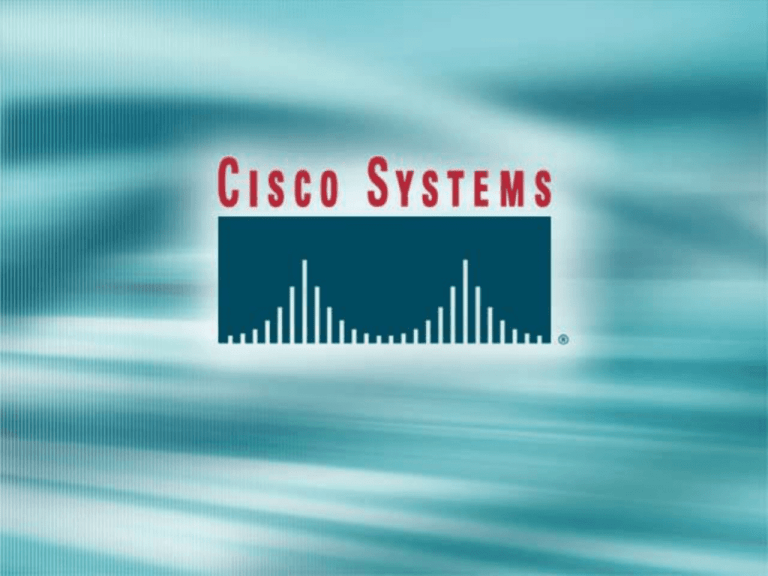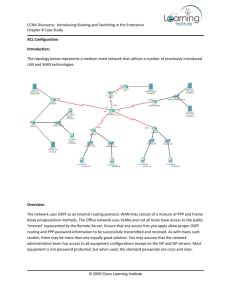
IP Addressing
RST-2002
© 2003, Cisco Systems, Inc. All rights reserved.
2
IP Addressing
• Basic Addressing
• Working with Addresses
• Summarization & Subnets
• VLSM
• Working with VLSM Networks
• Classful Addressing
• Working with Classful Addressing
RST-2002
© 2003, Cisco Systems, Inc. All rights reserved.
3
Basic Addressing
• IP addresses are
written in dotted
decimal format.
• Four sections are
separated by dots.
• Each section contains
a number between 0
and 255.
RST-2002
© 2003, Cisco Systems, Inc. All rights reserved.
Dots separate the sections
10.1.1.1
Each section
contains a number
between 0 and 255
4
Basic Addressing
• Why is each section a
number between 0 and 255?
• Computers operate in
binary, humans operate in
decimal.
• Computers treat IP
addresses as a single
large 32 digit binary
number, but this is hard
for people to do.
• So, we split them up into
four smaller sections so
we can remember and
work with them better!
RST-2002
© 2003, Cisco Systems, Inc. All rights reserved.
Dots separate the sections
10.1.1.1
Each section
contains a number
between 0 and 255
Why????
5
Basic Addressing
10.1.1.1
• 32/4 == 8.
•
28
= 256.
• But, computers
number starting at 0,
so to make a space of
256 numbers, we
number from 0 to 255.
RST-2002
© 2003, Cisco Systems, Inc. All rights reserved.
00001010 00000001 00000001 00000001
8
8
8
8
32
Each 8 digit group
represents a number
between 0 and 255
6
Basic Addressing
• Each device on a network
is assigned an IP
address.
• Each IP address has two
fundamental parts:
Host
• The host portion, which
identifies the host on
that wire.
00001010 00000001 00000001 00000001
Network
• The network portion,
which describes the
physical wire the device
is attached to.
10.1.1.1
• How can we tell the
difference between the
two sections?
RST-2002
© 2003, Cisco Systems, Inc. All rights reserved.
7
Basic Addressing
• The network mask shows
us where to split the
network and host sections.
RST-2002
© 2003, Cisco Systems, Inc. All rights reserved.
Host
• Each place there is a 0 in
the network mask, that
binary digit belongs to the
host portion of the
address.
00001010 00000001 00000001 00000001
Network
• Each place there is a 1 in
the network mask, that
binary digit belongs to the
network portion of the
address.
10.1.1.1
11111111 11111111 11111111 00000000
255.255.255.0
8
Basic Addressing
10.1.1.1
• An alternative set of
terminology is:
00001010 00000001 00000001 00000001
• The host portion of the
address is called the host.
• The network mask is
expressed as a prefix
length, which is a count of
the number of 1’s in the
subnet mask.
Host
Prefix
• The network portion of
the address is called the
prefix.
11111111 11111111 11111111 00000000
8
+
8
+
8
= 24
10.1.1.1/24
RST-2002
© 2003, Cisco Systems, Inc. All rights reserved.
9
Basic Addressing
• The network address is
the IP address with all
0’s in the host bits.
• The broadcast address
is the IP address with
all 1’s in the host bits.
• Packets sent to either
address will be
delivered to all the
hosts connected to the
wire.
RST-2002
© 2003, Cisco Systems, Inc. All rights reserved.
10
00001010
1
1
000000011 00000001
prefix
0/24
00000000
host
these bits are 0, so this is the network address
10
00001010
prefix
1
1
000000011 00000001
255/24
11111111
host
these bits are 1, so this is the broadcast address
10
Working with Addresses
• Two of the most
common questions
you are going to face
when dealing with IP
addresses are:
192.168.100.80/26
????
• What’s the network?
• What’s the host?
• How dow we figure
this out?
RST-2002
© 2003, Cisco Systems, Inc. All rights reserved.
11
Working with Addresses (The Hard Way)
• Divide by two, farm out the
remainder on the side.
• The bottom is the binary
MSD, the top the binary
LSD.
48
24
12
6
3
1
0
RST-2002
© 2003, Cisco Systems, Inc. All rights reserved.
remainder
0
remainder
0
remainder
0
remainder
0
divide by 2
divide by 2
divide by 2
divide by 2
remainder
divide by 2
remainder
divide by 2
remainder
divide by 2
remainder
Right
• Work with one octet at a
time.
96
divide by 2
0
0
1
1
Left
• First, convert the IP
address into binary. This
is easier than it looks.
192
12
Working with Addresses (The Hard Way)
Write down the IP
address.
11000000 10101000 01100100 01010000
192
168
100
80
If you have a prefix
length, just wrote
down the number of
1’s. If you have a
network mask,
computer the binary
as with the IP
address.
11111111 11111111 11111111 11000000
8
+8
+8
+2 == 26
AND these two.
11000000 10101000 01100100 01000000
Convert back to
dotted decimal. This
is the network
address.
192
RST-2002
© 2003, Cisco Systems, Inc. All rights reserved.
168
100
64
13
Working with Addresses (The Hard Way)
Write down the IP
address.
11000000 10101000 01100100 01010000
192
168
100
80
If you have a prefix
length, just wrote
down the number of
1’s. If you have a
network mask,
computer the binary
as with the IP
address.
11111111 11111111 11111111 11000000
8
+8
+8
+2 == 26
NOR these two.
00000000 00000000 00000000 00010000
Convert back to
dotted decimal. This
is the host address.
0
RST-2002
© 2003, Cisco Systems, Inc. All rights reserved.
0
0
16
14
Working with Addresses (The Hard Way)
128
1
128
• To convert from
binary to decimal, use
a simple chart.
64
0
0
32
1
32
16
0
0
• Add the number
indicated for each 1
set in the binary
number.
8
1
8
4
0
0
2
0
0
1
0
0
168
RST-2002
© 2003, Cisco Systems, Inc. All rights reserved.
15
Working with Addresses (The Easy Way)
• First, if you are using a
network mask, convert it
to a prefix length.
192 == 11000000
• For each octet in the
network mask that is 255,
add 8 to the prefix length.
255.255.255.192
8 +8 +8 +2 == 26
• For the one octet that isn’t
255, convert to binary and
add the right number of
bits--or use a chart!
RST-2002
© 2003, Cisco Systems, Inc. All rights reserved.
16
Working with Addresses (The Easy Way)
• Take the prefix length and
divide by 8.
• Take the resulting number,
and ignore those octets
out of the IP address-these are all part of the
network address!
• We’re going to use the
remainder to find the
fourth octet of the network
address.
RST-2002
© 2003, Cisco Systems, Inc. All rights reserved.
192.168.100.80/26
These three
octets are
part of the
network
26/8 == 3 (remainder 2)
The remainder tells us
what the network address
in the fourth octet is
17
Working with Addresses (The Easy Way)
• Take the remainder, and
find the corresponding
“multiple” on the chart; in
this case, 64.
• The largest multiple of 64
that will fit into 80 is 64, so
the network is 64.
• Add the three octets we
“set aside” earlier, and the
network (prefix!) is
192.168.100.64/26.
• 80 - 64 == 16, so the host
address is 16.
RST-2002
© 2003, Cisco Systems, Inc. All rights reserved.
Remainder == 2
8 7 6 5 4
3
2
1
1 2 4 8 16 32 64 128
64 x 1 == 64
64 x 2 == 128
Network is 64!
192.168.100.64/26
80 - 64 == 16
16 Hosts!
18
Working with Addresses (The Easy Way)
• How many hosts are in this
network? The remainder tells
us there are 64 addresses,
minus the network and
broadcast addresses, so 62
hosts.
• To find the broadcast
address, subtract 1 from the
number of hosts, and add
that number to the network
address.
• The key is to work in octets,
rather than trying to work
with the entire IP address at
once!
RST-2002
© 2003, Cisco Systems, Inc. All rights reserved.
Remainder == 2
8 7 6 5 4
3
2
1
1 2 4 8 16 32 64 128
64 addresses
64 - 2 == 62 hosts
64 + (64 - 1) == 127
192.168.100.127 is the
broadcast address
19
Working with Addresses (The Easy Way)
• What if the prefix length is
less than 24?
• Take the prefix length and
divide by 8.
• Take the resulting number,
and ignore those octets
out of the IP address-these are all part of the
network address!
• We’re going to use the
remainder to find the third
octet of the network
address.
RST-2002
© 2003, Cisco Systems, Inc. All rights reserved.
192.168.100.80/22
These three
octets are
part of the
network
22/8 == 2 (remainder 6)
The remainder tells us
what the network address
in the third octet is
20
Working with Addresses (The Easy Way)
• Take the remainder, and
find the corresponding
“multiple” on the chart; in
this case, 4.
• The largest multiple of 64
that will fit into 80 is 64, so
the network is 64.
• Add the two octets we “set
aside” earlier, and make
any octets after the
network 0’s (the fourth
octet).
• The network (prefix!) is
192.168.100.0/22.
RST-2002
© 2003, Cisco Systems, Inc. All rights reserved.
Remainder == 6
8 7 6 5 4
3
2
1
1 2 4 8 16 32 64 128
4 x 25 == 100
4 x 26 == 104
Third octet is 100!
Set the fourth octet to 0.
192.168.100.0/22
21
Working with Addresses (The Easy Way)
• To find the number of
hosts, take the number of
octets set to 0, which is 1
in this case (the fourth
octet), and multiply by
256.
• Next, take the number
relating to the remainder
from the chart, and
multiple this by the
number we just found
above.
“0” octets == 1
1 x 256 == 256
Remainder == 6
8 7 6 5 4
3
2
1
1 2 4 8 16 32 64 128
4 x 256 == 1024
1024 – 2 == 1022 hosts
• Subtract two.
RST-2002
© 2003, Cisco Systems, Inc. All rights reserved.
22
Working with Addresses (The Easy Way)
• The key is to work in octets, rather than
trying to work with the entire IP address at
once!
RST-2002
© 2003, Cisco Systems, Inc. All rights reserved.
23
10.1.1.8
10.1.1.7
10.1.1.4
• A single network address
(prefix!) represents a set
of hosts attached to a
wire.
10.1.1.2
Summarization & Subnets
• We can abstract this, and
simply say that a prefix
represents a set of
reachable addresses.
• We can say that we’ve
“summarized” information
about the hosts attached
to the physical wire by
referring to the entire
group as a single network.
RST-2002
© 2003, Cisco Systems, Inc. All rights reserved.
10.1.1.0/26
24
Summarization & Subnets
• In effect, we’ve shortened the
network part of the address
(prefix!), and lengthened the
host portion of the address,
in effect describing more
hosts (destinations) in a
single address.
• If we can shorten the prefix
length to describe multiple
hosts with a single network
address, why can’t we
shorten the prefix length so a
single network address
describes two networks?
• We can! It’s called address
summarization, or just
summarization.
RST-2002
© 2003, Cisco Systems, Inc. All rights reserved.
10.1.1.2/32
10.1.1.4/32
10.1.1.7/32
10.1.1.8/32
10.1.1.0/26
10.1.1.64/26
10.1.1.0/25
These
host
addresses
are
described
by this
network
These
networks
are
described
by this
network
25
Summarization & Subnets
10.1.1.0 through
10.1.1.31.
10.1.1.32 through
10.1.1.63.
10.1.1.0 through
10.1.1.63, so it’s the
same space!
00001010
10
11111111
00001010
10
11111111
00000001
1
11111111
00000001
1
11111111
00000001
1
11111111
00000001
1
11111111
00000000
0
11000000
01000000
64
11000000
00001010 00000001 00000001 00000000
10
1
1
0
11111111 11111111 11111111 10000000
Changing the mask bit from 1 to 0, which shortens the
prefix length, means the bit in the two networks that
distinguish them from one another are now considered
host bits!
RST-2002
© 2003, Cisco Systems, Inc. All rights reserved.
26
Summarization & Subnets
• A network which is a part
of another network is
called a subnet.
• There is another term, the
supernet, but it’s
definition depends on
whether you are using
VLSM subnetting, or
calssful subnetting, so it
will be defined in the next
two sections.
RST-2002
© 2003, Cisco Systems, Inc. All rights reserved.
10.1.1.2/32
10.1.1.4/32
10.1.1.7/32
10.1.1.8/32
10.1.1.0/26
10.1.1.64/26
10.1.1.0/25
These
host
addresses
are
subnets of
this
network
These
networks
are
subnets of
this
network
27
VLSM
• VLSM: Variable Length
Subnet Masking
• It simply means that the
entire IP address space is
treated as one flat address
space.
• Any prefix length is
allowed in the network at
any point.
RST-2002
© 2003, Cisco Systems, Inc. All rights reserved.
10.1.1.0/24
10.1.2.0/25
10.1.2.128/26
10.1.2.192/27
All of these are valid in
the same network!
28
VLSM
• At this point, you pretty much already know
VLSM! You already know how to find the network
address, broadcast address, and number of
hosts in a network.
• Two other common problems in working with
VLSM networks remain:
• Building summary addresses from groups of
networks. We won’t cover this here (maybe later in
routing).
• Building network addressing schemes from a given
number of hosts and networks.
RST-2002
© 2003, Cisco Systems, Inc. All rights reserved.
29
Working with VLSM Networks
• You have 5 subnets with the following numbers of hosts
on them: 58, 14, 29, 49, 3
• You are given the address space 10.1.1.0/24.
• Determine what subnets you could use to fit these hosts
into it.
• How to solve this:
• Start with the chart!
• Order the networks from the largest to the smallest.
• Find the smallest number in the chart that will fit the number
of the largest number of hosts + 2.
• Continue through each space needed until you either run out
of space, or you finish.
RST-2002
© 2003, Cisco Systems, Inc. All rights reserved.
30
Working with VLSM Networks
• 58, 14, 29, 49, 3: reorder to
58, 49, 29, 14, 3. Start with 58.
• Smallest number larger than
(58 + 2) is 64. 64 is 2 bits.
• 24 bits of prefix length in the
address space given, add 2
for 26.
• First network is 10.1.1.0/26.
• The next network is 10.1.1.0 +
64, so we start the next
“round” at 10.1.1.64.
RST-2002
© 2003, Cisco Systems, Inc. All rights reserved.
8 7 6 5 4
3
2
1
1 2 4 8 16 32 64 128
32 < (58 + 2) < 64
24 + 2 == 26
10.1.1.0/26 takes
care of the first 58
hosts
Start the next block
at 10.1.1.64
31
Working with VLSM Networks
• Next block is 49 hosts.
• Smallest number larger than
(49 + 2) is 64. 64 is 2 bits.
• 24 bits of prefix length in the
address space given, add 2
for 26.
• We start this block at
10.1.1.64, so network is
10.1.1.64/26.
• The next network is 10.1.1.64
+ 64, so we start the next
“round” at 10.1.1.128.
RST-2002
© 2003, Cisco Systems, Inc. All rights reserved.
8 7 6 5 4
3
2
1
1 2 4 8 16 32 64 128
32 < (49 + 2) < 64
24 + 2 == 26
10.1.1.64/26 takes
care of the next 49
hosts
Start the next block
at 10.1.1.128
32
Working with VLSM Networks
• Next block is 29 hosts.
• Smallest number larger than
(29 + 2) is 32. 32 is 3 bits.
• 24 bits of prefix length in the
address space given, add 3
for 27.
• We start this block at
10.1.1.128, so network is
10.1.1.128/27.
• The next network is
10.1.1.128 + 32, so we start
the next “round” at
10.1.1.160.
RST-2002
© 2003, Cisco Systems, Inc. All rights reserved.
8 7 6 5 4
3
2
1
1 2 4 8 16 32 64 128
16 < (29 + 2) < 32
24 + 3 == 27
10.1.1.128/27
takes care of the
next 29 hosts
Start the next block
at 10.1.1.160
33
Working with VLSM Networks
• Next block is 14 hosts.
• Smallest number larger than
(14 + 2) is 16. 16 is 4 bits
(actually equal, but it still
works!).
• 24 bits of prefix length in the
address space given, add 4
for 28.
• We start this block at
10.1.1.160, so network is
10.1.1.160/27.
• The next network is
10.1.1.160 + 16, so we start
the next “round” at
10.1.1.176.
RST-2002
© 2003, Cisco Systems, Inc. All rights reserved.
8 7 6 5 4
3
2
1
1 2 4 8 16 32 64 128
(14 + 2) == 16
24 + 4 == 28
10.1.1.160/28
takes care of the
next 14 hosts
Start the next block
at 10.1.1.176
34
Working with VLSM Networks
• Last block is 3 hosts.
• Smallest number larger than
(3 + 2) is 8. 8 is 5 bits.
• 24 bits of prefix length in the
address space given, add 5
for 29.
• We start this block at
10.1.1.176, so network is
10.1.1.176/29.
• This is the last block of
hosts, so we’re done!
RST-2002
© 2003, Cisco Systems, Inc. All rights reserved.
8 7 6 5 4
3
2
1
1 2 4 8 16 32 64 128
4 < (5 + 2) < 8
24 + 5 == 29
10.1.1.176/29
takes care of the
next 14 hosts
35
RST-2002
© 2003, Cisco Systems, Inc. All rights reserved.
10.1.2.0/25
10.1.2.128/25
10.1.2.128/26
subnets
10.1.1.0/24
10.1.2.0/24
subnets
10.1.0.0/23
subnet
supernet
• A supernet is any network
which covers a larger
space than a given
network, including the
space covered by the
network.
supernet
• A subnet is any network
which is “part of” a larger
network space.
supernet
Working with VLSM Networks
36
Classful Addressing
• Classful subnetting is similar to VLSM,
with two more rules:
• The IP address space is divided into
“classes,” with each class having a specific
“natural” prefix length. Each block of
address space is called a “major net.”
• You cannot have more than one prefix length
within a major net.
RST-2002
© 2003, Cisco Systems, Inc. All rights reserved.
37
Classful Addressing
Network Class
Beginning
Digits in
Binary
Natural Range of
Prefix
Addresses
Length
Example Major
Networks
Class A
10XX
8
1.0.0.0/8
through
126.0.0.0/8
11.0.0.0/8
100.0.0.0/8
120.0.0.0/8
Class B
110X
16
128.0.0.0/16
through
191.0.0.0/16
130.1.0.0/16
148.45.0.0/16
190.100.0.0/16
Class C
1110
24
192.0.0.0/24
through
223.0.0.0/24
193.1.3.0/24
193.1.4.0/24
192.2.5.0/24
RST-2002
© 2003, Cisco Systems, Inc. All rights reserved.
38
Classful Addressing
• It’s illegal to have multiple
network masks within a
single major network.
• There cannot be a mix of
/24’s and /25’s in the
10.0.0.0/8 major network.
• There cannot be a mix of
/25’s and /26’s in the
11.0.0.0/8 network.
RST-2002
© 2003, Cisco Systems, Inc. All rights reserved.
10.1.1.0/24
10.1.2.0/24
10.1.3.0/25
10.1.3.128/25
two different
prefix lengths
in the same
major network
11.1.1.0/25
11.1.1.128/26
39
Working with Classful Addressing
• You can find the network address,
broadcast address, and number of hosts
as we described earlier.
• You can find the number of networks by
subtracting the network mask from the
natural mask, and then using the chart.
RST-2002
© 2003, Cisco Systems, Inc. All rights reserved.
40
Working with Classful Addressing
• 10.1.1.0/25 is in the
10.0.0.0 class A major
network.
• The natural prefix length
for a class A network is /8.
• Subtract the natural prefix
length from the actual
prefix length.
10.1.1.0/25
10.0.0.0/8 is class A
25 – 8 == 17
17/8 == 2, 1 remaining
• Divide by 8, holding the
remainder on the side.
RST-2002
© 2003, Cisco Systems, Inc. All rights reserved.
41
Working with Classful Addressing
• Find the remainder in
the power of two’s
chart.
• Multiply the result,
256, and the number
from the power of
two’s chart.
10.1.1.0/25
10.0.0.0/8 is class A
25 – 8 == 17
17/8 == 2, 1 remaining
(256 x 2) x 128 == 65536
8 7 6 5 4
3
2
1
1 2 4 8 16 32 64 128
• Subtract 2.
65536 – 2 == 65534 networks
RST-2002
© 2003, Cisco Systems, Inc. All rights reserved.
42
Working with Classful Addressing
• Subnet 0
• The network with
all the between the
host and the
natural major net
set to 0.
• This only exists in
classful
addressing
schemes.
10
00001010
0
00000000
natural
network
natural
host
© 2003, Cisco Systems, Inc. All rights reserved.
0/24
00000000
configured
these bits are 0, so this is subnet 0
network
10.0.0.0/16
Yes
10.0.1.0/16
No
172.31.0.0/24
Yes
172.31.1.0/24
No
192.168.100.0/25
RST-2002
0
00000000
Yes
43
Working with Classful Addressing
• Broadcast Subnet
• The network with
all the bits
between the host
and the natural
major network set
to 1.
• This only exists in
calssful address
schemes.
10
00001010
255
11111111
natural
network
natural
host
© 2003, Cisco Systems, Inc. All rights reserved.
0/24
00000000
configured
these bits are 1, so this is the
network
broadcast network
10.255.0.0/16
Yes
10.255.0.0/24
No
172.31.255.0/24
Yes
172.31.255.0/25
No
192.168.100.128/25
RST-2002
255
11111111
Yes
44
Working with Classful Addressing
• You have 5 subnets with the following numbers of hosts
on them: 58, 14, 29, 49, 3
• You are given the address space 10.1.0.0/22.
• Determine what subnets you could use to fit these hosts
into it.
• How to solve this:
• Start with the chart!
• Find the largest set of hosts.
• Find the smallest number in the chart that will fit the number
of the largest number of hosts + 2.
• Use that prefix length for all the subnets (remember you
cannot have different subnet masks within the same major
network).
RST-2002
© 2003, Cisco Systems, Inc. All rights reserved.
45
Working with Classful Addressing
• A subnet is any prefix with
a prefix length longer than
the natural prefix length of
the major network.
• A supernet is any prefix
with a prefix length
shorter than the natural
prefix length of the major
network.
RST-2002
© 2003, Cisco Systems, Inc. All rights reserved.
172.18.1.0/24
Subnet
10.2.0.0/9
Subnet
172.34.0.0/15
192.168.44.64/25
192.168.44.0/23
Supernet
Subnet
Supernet
46
Private & Special Address Space
Address Space
Range of Addresses
10.0.0.0/8
10.0.0.0 through 10.255.255.255
172.16.0.0/19
172.16.0.0 through 172.31.0.0
192.168.0.0/16
192.168.0.0 through 192.168.255.255
Network Class
Beginning Digits in Binary
Range of Addresses
Class D
(Multicast)
11110x
224.0.0.0 through
239.255.255.255
Class E
(Experimental)
11111x
240.0.0.0 through ....
RST-2002
© 2003, Cisco Systems, Inc. All rights reserved.
47
Cisco IOS Show IP Route
2651A#sho ip route
....
Gateway of last resort is not set
two different prefix
lengths under the
same major
network
C
208.0.12.0/24 is directly connected, Serial0/2
....
S
208.1.10.0/24 [1/0] via 208.0.12.11
....
144.2.0.0/16 is variably subnetted, 2 subnets, 2 masks
S
144.2.2.0/24 [1/0] via 208.0.12.11
S
144.2.3.0/29 [1/0] via 208.0.12.11
C
208.0.7.0/24 is directly connected, Serial0/0
C
208.0.6.0/24 is directly connected, FastEthernet0/0
C
208.0.0.0/24 is directly connected, FastEthernet0/1
S
208.1.0.0/16 [1/0] via 208.0.12.11
a supernet and natural
mask in the same
network address space
RST-2002
© 2003, Cisco Systems, Inc. All rights reserved.
48








